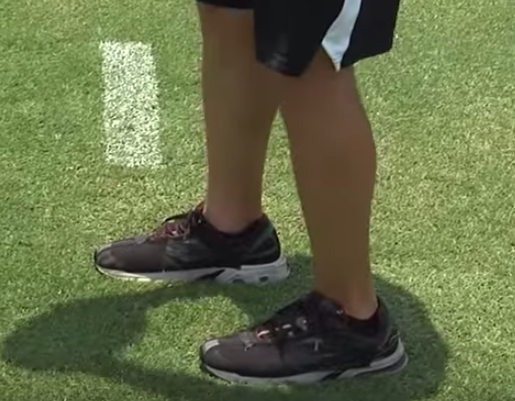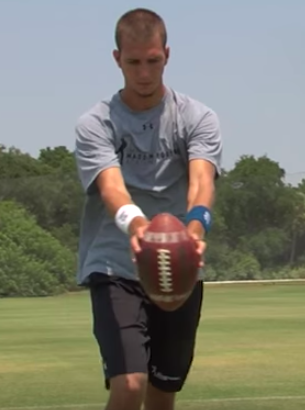Punting a football farther and higher is a valuable tool. Having a great kicker is one of the best assets to have in football. Pinning the opponent deep in their own territory is not only good for the defense, but it will also ultimately give the offense a better field position.
The art of kicking football has evolved over the years. Both punting and field goal kicking has been influenced by other sports. Rugby and Soccer have brought different styles to the game that kickers 50 years ago couldn’t even imagine.
We’re going to break down fundamentally how to kick a football both from a punt and field goal position. First, let’s learn a little history on field goal kicking to understand why some styles of kicking work and why others have faded out.
Field Goal Kicking
We’re not going to bore you with the old leather helmet footage of kicking field goals. But rather, we want to bring you back in time, when soccer-style kicking was introduced. Introducing a man who changed professional football history, Pete Gogolak.
Pete had a unique, never-seen style of kicking. He took a soccer-style approach ( which pretty much every kicker uses), kicking with the top of the shoe rather than die with the toe. Pete, a Hungarian native, played soccer his whole life. He went to school at Cornell University, where he would kick his soccer-style field goals.
When Gogolak first got into the league, people thought it was a fad. Similar to how the wildcat was first received. There are a few reasons why soccer-style kicking is used primarily by every field goal kicking player:
- More Accurate
- Hips Are Involved
- Surface Area Expanded
Kickers started to become more accurate with the soccer-style kick. According to scientificamerican.com,
But by the mid-1970s more placekickers were using soccer-style than a toe kick. By the late 1980s, toe-ballers were extinct, because soccer kickers were generally making more of their attempts. The field-goal completion rate across the league in the early 1960s was typically less than 60 percent; today it is around 80 percent. And most of the longest field goals ever made have been kicked soccer style.
On top of the accurate kicks, the distance of kicks also increased due to players being able to engage their hips in every kick.
On top of more power, increasing the surface area ( using the top of the shoe, not just the toe) allowed for kickers to generate a better strike on the ball. As Scientific American says:
When a toe-baller kicks, only the cross-section of the front tip of his shoe contacts the ball. In soccer style , the whole instep of the shoe (the arched portion, along the inside of the laces) makes contact. The greater surface area of contact gives the kicker more control over the ball’s flight path. Put another way, a toe-baller has to strike the ball almost perfectly head-on to put it on a successful path, because the contact point is so small. In a soccer kick, the greater contact area provides more margin for error.
Soccer style also imparts more force from the human to the pigskin, sending it farther. For a toe-baller, all the force is generated by the kicking leg, which swings in line under the hip like a pendulum. With soccer style, approaching the ball from the side allows the kicker’s hip to rotate, which creates more foot velocity. “The angled approach allows for greater use of hip momentum, which creates more rotational momentum—more angular momentum—in the foot,” says William Barfield, a specialist in biomechanics and orthopedic science at the College of Charleston and the Medical University of South Carolina. More angular momentum creates greater foot speed, which delivers more force to the ball.
Rotational momentum helps other athletes as well. Imagine standing at home plate with your body rigid, trying to swing a bat at a baseball with just your arms. Now imagine being able to twist your body as your arms swing; that’s much more natural, and you can hit the ball harder.
Having the leg twist and including the hips and major muscle groups in the leg led to more field goal opportunities.
Teams could now get the ball inside the 35-yard line and walk away with points. Pete Gogolak changed kicking for the better in 1964!
Kicking Field Goals More Consistently
There are a few things to focus on while improving your kicking:
- Approach
- Strike-point
- Follow Through
- Building Strength
All of the techniques we’ll be teaching in this article will refer to soccer-style kicking.
Approach
Taking the proper alignment steps, approach steps, and follow-through steps are the foundation of field goal kicking. If your set, approach, and follow-through steps are off, the trajectory and strike of the kick will be thrown off drastically.
Always start with your plant foot next to the ball and kicking your foot behind the football. From there, take 2 large steps back and two to the side. Have a slightly forward lean toward the ball, with your eyes focused on where the ball will be.
This will position your body to kick the ball soccer style with maximum output from your hips and legs. Here is a video from IMG academy demonstrating the kick:
As we’re approaching the football, we want to make sure our ankle is locked, which will help give the leg the “whip” motion to launch the football.
Strike-Point
The aiming point for kicking a football is between the toe and ankle. It’s the hardest spot on your foot which will help generate the most power. Here is an image to show you exactly where we want to hit.

Using the picture of the shoe above, we want to aim for the inside bottom of the laces. This is the part where our foot can generate the most power with the given surface area.
Follow Through
The kick doesn’t stop on contact. Following through is one of the most important parts of being accurate with your kick. If you’re a former soccer player, there’s a good chance that you’ll want to swing your leg across your body.
This makes sense, as you’re trying to add spin to the ball as you’re kicking it. Football is the complete opposite. When we make contact with the football, we want our leg to follow through the football straight.
This will make the ball launch off our foot with only a slight draw/fade (depending on your swing), rather than tilting off completely to the left or right. Study these motions to kick the ball high off the ground or tee effectively. For more visual references – we recommend watching these IMG academy kicking videos!
Punting
Punting is a bit different than kicking. Great kickers oftentimes don’t translate to great punters. There are different approaches, strike points, and techniques to punting a football.
Let’s break down the punt and how it’s evolved throughout the year.
The Spiral Punt
The Spiral punt was invented in the 1880s by Alex Moffat. Alex played for Princeton University, and he revolutionized the way we kick the football today. He learned that if he tilted the ball a certain way and caught his foot at the right angle, it would spiral off his foot.
This was significant because players would kick the football normally and have it roll to their opponent. The aerodynamics of the spiral meant it could cut through the air and create more hang time on a well-placed kick. Another fun fact about Alex Moffat, he could kick equally as well with both feet.
Punting Technique
As with kicking a field goal, punting is extremely technical. Every movement made can alter the height and trajectory of the football. Let’s study each piece of punting.
- Approach and Stance
- Ball Drop
- Contact
Approach and Stance
Stand with your feet slightly staggered, roughly 12-15 yards behind the long snapper. It’s important not to have one foot so far in front of the other; in case of a bad snap, it’ll be tough for you to move laterally. Note the picture below as to how staggered we want our stance.

Dropping The Punt Properly
Dropping the punt to the foot is one of the hardest parts of punting. Missing the sweet spot by an inch can cause the punt to be “shanked” off the side of your foot. This motion should be repeated hundreds/thousands of times until it’s completely mastered.

We want the ball to be loaded up on the side hand that we kick with. Gently place the ball in your palm with the thumb supporting the top and palm bracing the bottom.
The second hand should cover the side of the football for support. This is the most important part of the punt. For a visual reference on the drop, reference the video below from IMG Academy.
See Our Complete List Of Helpful Football Articles Here
Steps & Kicking A Punt
Now that we’ve gone over the hold, we need to look into the steps and actually kick. The steps should be 1, 2, kick. Remember, everything is timed from snap to kick to give your blockers a chance to block and release.
Once we catch the football, hold it out in front of you and take a maximum of two steps.
The actual punt should be treated similarly to the field goal kick. The knee and the toe should be locked out as the leg is swung forward. As the leg comes forward, we make sure our chest is up and our leg is driving up through the football.
Swing the leg high and hard through the football to generate as much power as possible.
Different Variations Of Punting
Punting started to become more creative as coaches started to get more creative. Different types of punts can be executed:
- Drop Punt
- Rugby Punt
The drop punt was introduced to the league to spin the ball back inside the 10-yard line. This style of kick is trendy in rugby and was brought over from that sport.
The drop punt requires the punter to kick the football at a 180-degree angle. This kick is tough to hit, but it can be very effective when to hit and mastered. Note the picture and video below on how to do a drop punt.

Here is a video to give you a better visual reference.
The rugby-style punt is another punt that many colleges and high school teams have implemented into their systems. The rugby punt is an “on the move” punt, which allows the punter and the protection to roll toward the punter’s kicking leg.
What it’s most useful for is the fact that the punter can delay when he kicks it. It allows his cover team to get down the field and suffocate the return. It’s hard to get used to, but if you have a player who can do it, it can prove to be extremely useful.
Conclusion
Punting and Kicking are a major part of the game—1/3 of the game, to be exact. Field position is everything in football, and teams that can kick field goals consistently and pin their opponents inside their own zone will find themselves in better positions to win football games.
